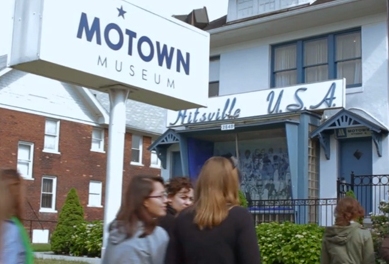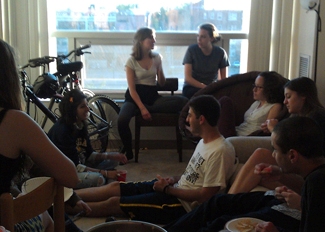
Students in the Semester in Detroit program visit Hitsville USA.
There they were, all 24 U-M students, crowded into a converted garage connected to a modest house on Detroit’s West Grand Boulevard, singing a cappella—and from memory:
“I’ve got sunshine on a cloudy day. When it’s cold outside, I’ve got the month of May. I guess you’d say, ‘What can make me feel this way?’ My girl, my girl, my girl. Talkin’ ’bout my girl. My girl!”
As they finished, the group burst out laughing and clapping—these young folks who were born more than 30 years after the original Temptations recorded “My Girl” for Motown Records in this very place.
For the Record
The students’ tour of “Hitsville USA” was just one outing to complement coursework about the history of Detroit, taught by Dr. Stephen Ward, associate professor in the Residential College (RC) and the Department of Afroamerican and African Studies.
“I have always been a fan of Motown but, to be honest, I had never really associated it with Detroit,” says Mary Naoum, 20, a sophomore majoring in theater arts. Prior to the tour of the recording studio, Naoum and her classmates learned about entrepreneur Berry Gordy Jr. to gain a clear understanding of the company’s significance beyond mere music. “Learning about Motown in class and going to the museum made me proud to be associated with Detroit,” she says.
In a previous lesson, students watched a video about the 1967 Detroit riots, then piled into cars and joined Dr. Angela Dillard, director of the RC, on the very corner where the riots began. Dillard’s family lived in the area prior to and during the riots. As their instructor set the stage for that chaotic summer, the students stood transfixed as history came alive.
It was all so … evocative.
And it was all so … Semester in Detroit.
http://www.youtube.com/watch?v=6DbtCrmRF50
A New Kind of Classroom
This day’s events, which occurred in June, were typical of what students do, and how they do it, during the Semester In Detroit (SID) program, now entering its fourth year. The comprehensive program’s three pillars require students to live, study, and work in Detroit, immersing them in a city most of them know little about.
“This is what we believe makes us most distinctive,” says Craig Regester, SID associate director. He has lived in the city since 1995 and strives to integrate specific coursework to the landscape of Detroit. “Each of these three programmatic aspects strengthens and illuminates the others; ultimately, this enables our students to engage with Detroit in substantive and serious ways.”
The program combines lectures and coursework with excursions related to in-class concepts and theories. Students have studied then visited the defunct Packard Automotive Plant, the landmark Guardian Building, and the historic Ossien Sweet home, site of racial unrest dating back to 1925. They also have explored the Detroit Institute of Arts and the Ford River Rouge Complex, among others.
Students take classes with titles like “Planning Detroit: Past, Present, Future”; at the same time they learn from some of the city’s leaders and most prominent citizens by way of a Detroit speaker series. They also take electives and may even take courses at Wayne State University. The SID program is funded by the Office of the Provost and administered through the Residential College. The program also receives support from the College of Literature, Science, and the Arts.
In addition to coursework, students complete a community-based internship with SID partners, nonprofit and community organizations that deliver a crucial component of the student-city integration. Students work 16 hours per week for their sponsors, which range from the Museum of Contemporary Art Detroit to the Hub,a nonprofit bicycle reuse and repair shop. An internship reflection seminar helps contextualize the experience.
Live and Learn
“SID redefines both the real and imagined boundaries of the traditional classroom,” says Regester, noting that SID originated from a student idea. “The program enables students to maintain a constant dialogue among theory, history, and practice as they intertwine their everyday lives with this great American city.”
Sophomore Naoum, who grew up in Troy, Mich., was a typical suburban youth who saw Detroit through the lens of her parents, a lens mostly trained on the fact that Detroit was in decline. But she also had explored Detroit with her friends in high school, and found a vibrant and spontaneous city rich with art and theater.
Naoum’s career goal to help produce social change through theater led her to SID. She lived in the city, studied at the Detroit Center, and interned at the Matrix Theatre Company, a nonprofit “aimed at using the transformative power of theater to create social change.” She shadowed the executive director and acted as community engagement coordinator. During her time there, the company was working on its “Ghost Waters Initiative,” which focuses on environmental sustainability in Detroit.
She loved every minute of the entire SID program, she says. And, “as the term continued, I came to realize that, yes, my parents’ interpretation of the city’s current state has validity. But so did my high school view. One view without the other is an incomplete narrative of the city.”
Continuing Education
Sam Morykwas, a 21-year-old political science major and also a Troy native, already had been volunteering in Detroit with a nonprofit called Neighbors Building Brightmoor. Brightmoor is an older Detroit neighborhood on the rebound. Regester agreed to add the nonprofit to the growing list of SID partners so Morykwas could continue his work as part of his studies.

Students learn about the Detroit nonprofit Neighbors Building Brightmoor, one of SID’s internship partners.
“I love the people and community there, so I wanted to use the internship to deepen my connection,” Morykwas says. He worked with youth in art workshops, did career training of high schoolers with the Brightmoor Youth Development Collaboration, helped build the organization’s website, and distributed fliers door to door. It was total immersion and a lesson in life. He saw people fight to save their neighborhood one day and a friend’s car get stolen the next.
“The true story of Detroit lies in contrasts,” Morykwas says. “It is not solely about the crime and struggles, but it is also not just about successes of new towns and organizations. It is about the back-and-forth Detroiters face every day with bombardments from each side. You could see something that will mess up your whole perspective one day, and the very next be part of something that gives you more hope than ever.”
School of Thought
SID continues to gain traction among U-M students intrigued by Detroit. But exactly how is its success measured? Says RC director Dillard, “SID uses the same assessment modules as any other class. Students complete coursework, including research papers, creative projects, and other assignments, which are graded in conventional ways with letter grades.
“But in a larger sense, we measure our success by the levels of engagement students demonstrate in the various aspects of the learning experience, especially work at their internship sites—for which they produce final projects and papers—and the reflection essays and discussions that occur weekly.
“We also are beginning to increasingly chart the subsequent experience of SID alums,” Dillard continues. “If a student decides to spend the following summer, after the term, living and working productively in Detroit, then we judge that as a success.” Several have done so, she says. “Other alums have taken longer-term positions at their former internship sites, while still others have gone on to do graduate work directly inspired by their experiences in the city.”
So how do Morykwas and Naoum stack up on that measure? Well, let’s see:
Morykwas, now living back in Ann Arbor, is still working to strengthen the partnership between Neighbors Building Brightmoor and the U-M student organization dedicated to that connection. His personal goal as one of the founding members of the group is to transition leadership further to younger members, and to help guarantee the connection’s longevity.
Naoum still lives in Detroit and is working for the nonprofit Summer in the City. Through this group, she helps high school students volunteer in Detroit’s urban gardens and paint murals. She also works with kids at a summer day camp and interacts with some of the city’s largest employers.
Impressive, for sure. But of course, all of this is not just a matter of community involvement or academic success. At this point it’s personal.
As Naoum puts it: “I am now so emotionally invested in Detroit.”
This story is part of an online series titled “Michigan’s World Class,” which details the creative new ways Michigan faculty share knowledge, address issues of the day, and equip future leaders with the skills and confidence they need to solve some of society’s most vexing problems.




Michele Worden
This article seems very much to describe two education philosophies though they are never mentioned by name: place-based education and project-based education. I am on the board of a charter middle school that focuses on and incorporates both approaches. It can be an uphill battle to explain the value of these approaches to parents. If great articles like this used these terms to describe a program that is clearly following these pedagogies, it would really help to gain a broader understanding and acceptance of this very effective educational model.
Reply